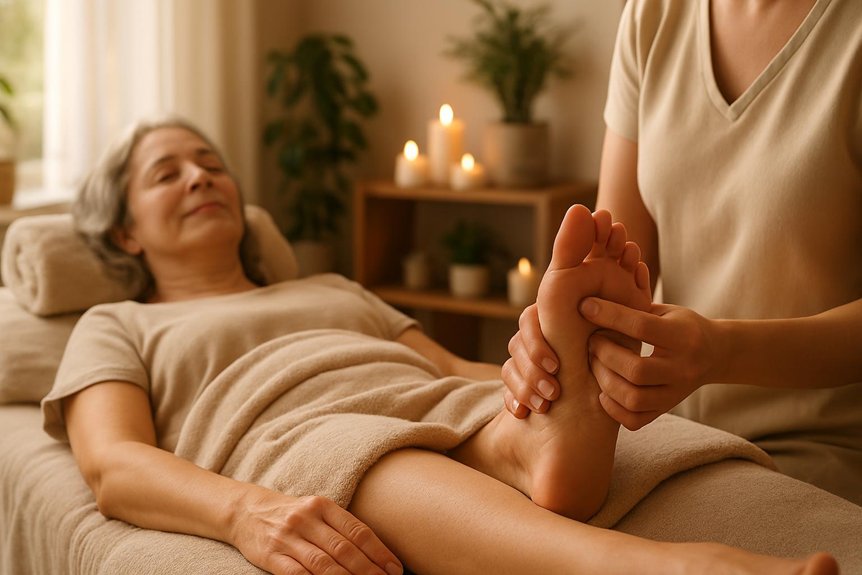Reflexology may offer supportive relief during menopause by applying targeted pressure to mapped points on the feet, hands, or ears to promote relaxation and modulate stress responses. Small studies suggest potential benefits for perceived stress, sleep quality, hot flushes, mood variability, and general wellbeing, though evidence remains mixed and it should not replace medical care. Sessions are typically 45–60 minutes and generally safe with screening. Combining with sleep hygiene, gentle movement, and hydration may enhance outcomes. Further details can clarify suitability and expectations.
How Reflexology Works and Why It’s Considered for Menopause

While menopause is a natural life stage, many seek non-pharmacological options to manage symptoms; reflexology is one such approach. Reflexology applies targeted pressure to mapped points on the feet, hands, and ears that correspond to organs and systems.
Mechanistically, it may modulate autonomic balance, downshift stress responses, and support perceived relaxation through sensory–neural pathways. Small studies suggest benefits for stress, sleep quality, and overall wellbeing, though evidence remains mixed and not a replacement for medical care.
At Spa & Massage clinics across London, therapists use structured protocols, gentle-to-firm pressure, and paced breathing to foster calm. Sessions are adapted to each person’s health history and preferences, with clear consent and modest draping to maintain comfort.
Clients are encouraged to integrate hydration, light movement, and regular session cadence. Additionally, incorporating techniques from sports massage benefits may enhance athletic recovery and overall wellbeing when used alongside reflexology.
Key Menopausal Symptoms Reflexology May Support
A reflexology programme may help ease several common menopausal complaints by reducing perceived stress, promoting relaxation, and supporting sleep regulation. Evidence suggests reflexology can modestly reduce anxiety, improve subjective sleep quality, and help clients feel calmer during hormonal fluctuations.
Many also report fewer or less intense hot flushes and night sweats, likely via downregulation of sympathetic arousal.
Clients often seek support for mood variability, low energy, and irritability; gentle foot and hand techniques may enhance parasympathetic tone, easing tension and emotional reactivity.
Some experience relief from headaches, joint discomfort, and bloating, possibly through improved circulation and relaxation of surrounding musculature.
While not a cure, our therapists at Spa & Massage use structured, client-led reflexology plans that complement medical care, prioritising comfort, consistency, and measurable outcomes.
What to Expect in a Reflexology Session at Spa & Massage
On arrival, clients complete a brief health consultation to identify menopausal symptoms, contraindications, and goals, followed by a therapist-led explanation of the reflexology plan, duration, and expected sensations.
The session typically lasts 45–60 minutes at Spa & Massage clinics across London.
Feet are cleansed; clients recline, fully clothed except for footwear, with modest draping for warmth and privacy.
A neutral hypoallergenic balm is applied; aromatherapy can be added on request.
Therapists use calibrated thumb-walking and gentle holds on foot reflex zones linked to sleep, vasomotor regulation, pelvic hormones, and stress response.
Pressure is adjusted to comfort.
Clients may notice tenderness at specific points, a spreading warmth, or a soothing heaviness—signs of nervous-system downregulation.
Post-session, therapists share observations, personalised self-care points to press at home, hydration guidance, and suggested visit frequency.
Safety, Contraindications, and When to Seek Medical Advice
After outlining what a typical reflexology session entails at Spa & Massage, attention turns to safety and when medical input is warranted. Reflexology is generally low risk when delivered by trained therapists, yet it is not a substitute for medical care.
Contraindications include acute deep vein thrombosis, uncontrolled hypertension, active skin infections on the feet or hands, recent fractures or surgery to the lower limbs, severe peripheral neuropathy, and active gout flares. Caution is advised with diabetes, circulatory disorders, osteoporosis, and anticoagulant use; pressure is adjusted accordingly.
Medical advice should be sought for new vaginal bleeding after 12 months amenorrhoea, chest pain, severe headaches, unilateral leg swelling, fainting, unexplained weight loss, or persistent pelvic pain. Spa & Massage therapists screen discreetly, adapt techniques, and will pause treatment if red flags arise.
Self-Care Tips and How to Combine Reflexology With Other Wellness Habits
Thoughtful self-care can enhance the effects of reflexology during menopause by stabilising sleep, mood, and pain thresholds. Spa & Massage advises pairing regular foot reflexology with consistent sleep routines, gentle movement, and paced breathing.
Evening sessions, followed by a warm bath and low lighting, can reduce sympathetic arousal and night sweats. Hydration and balanced meals with protein and phytoestrogen-rich plants may support energy and temperature control.
Our therapists recommend daily self-reflexology between sessions: slow circular pressure on the solar plexus point (centre of the foot), followed by the pituitary and adrenal zones, for five minutes per foot.
Many clients combine reflexology with aromatherapy massage using lavender or clary sage blends in our clinics to ease tension.
Tracking symptoms in a diary helps tailor frequency, intensity, and aftercare.
Conclusion
Like a lighthouse steering ships through shifting tides, reflexology is presented as a steady guide rather than the shore itself. Evidence remains mixed, yet early studies and client reports suggest benefits for stress, sleep, and perceived balance. Within a patient-centered plan—medical review, symptom monitoring, and lifestyle measures—Spa & Massage positions reflexology as supportive care. Safety screening, clear goals, and collaboration with clinicians help guarantee that each session serves as a navigational beacon on the menopausal voyage.